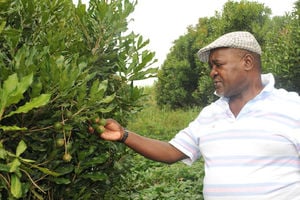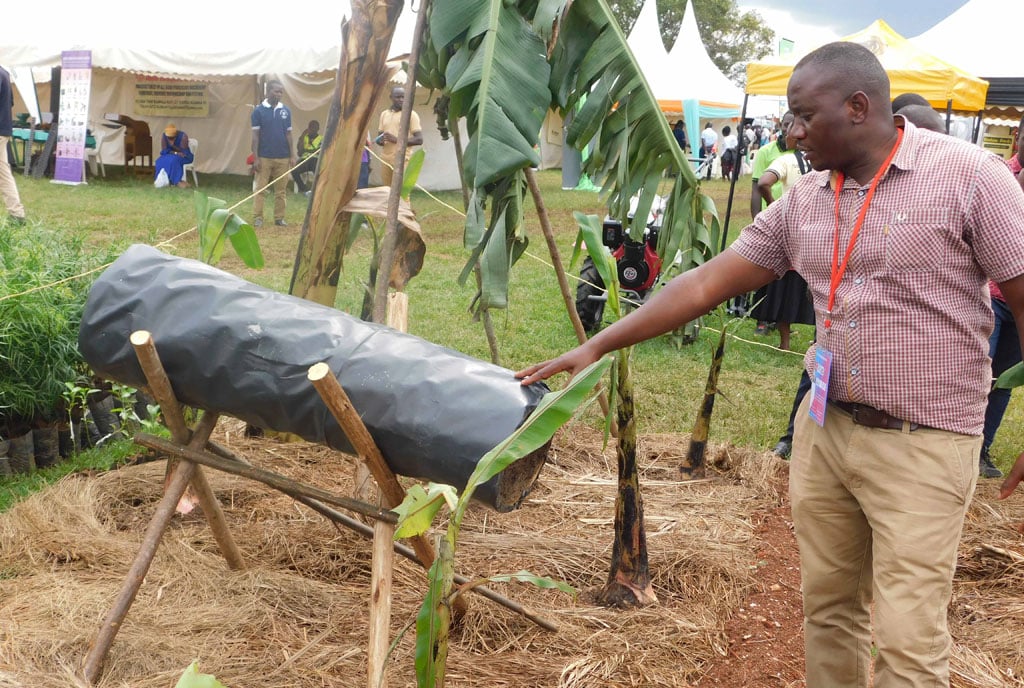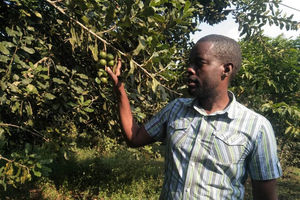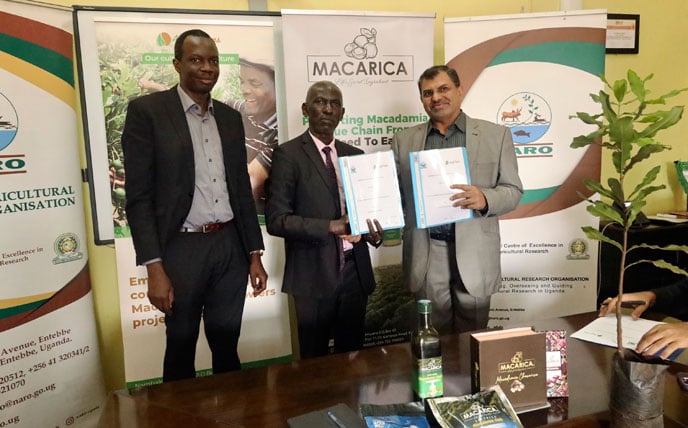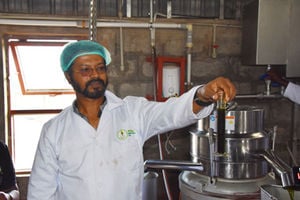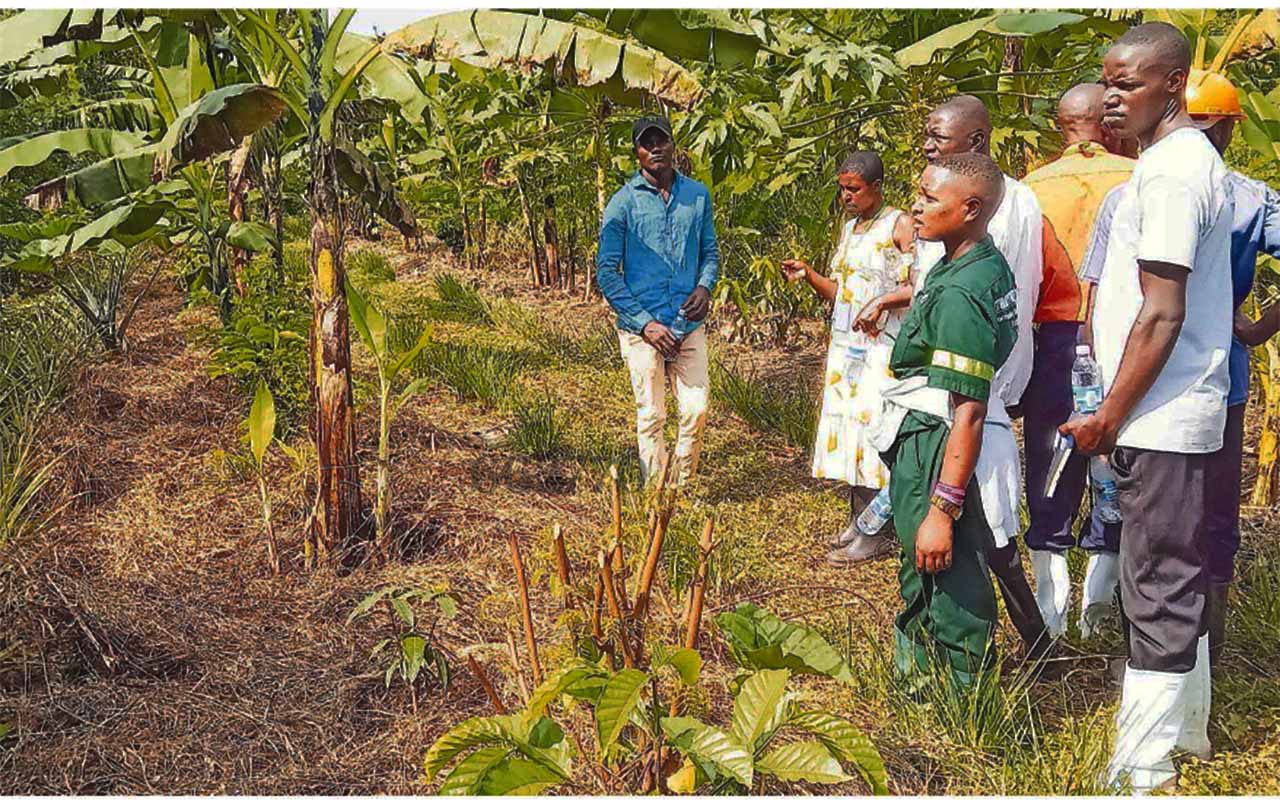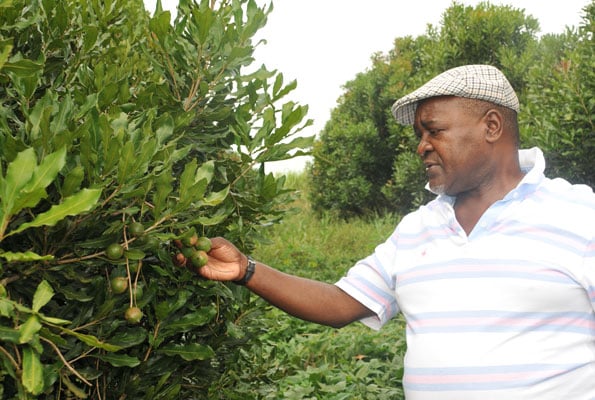
Former vice president Gilbert Bukenya inspects a macademia plant PHOTO COURTES
Macadamia is a tree which produces macadamia nuts, and it is the most expensive nut on the world market. The tree span stretches from 80 to 100 years
The tree belongs to the genus Macadamia which contains four species of tree or shrub in the family Proteaceae which are grown for their edible nuts.
It is a fast growing, regular shaped, medium-sized and evergreen tree with heavy, dark and green foliage.
The nut has a smooth hard shell which coats the kernel in a leathery two valved case that is 1 inch in diameter.
Background
The macadamia tree has its origins in Australia, where the Aborigines discovered the nut thousands of years ago.
According to available statistics the global production in 2015 was 160,000 Tonnes and those days it was an important source of bush food which has since been adopted by farmers across the world. The trees are also grown as ornamental plants in subtropical regions for their glossy foliage and attractive flowers. The flowers produce a well-regarded honey. The wood is used decoratively for small items.
In Uganda the plant was introduced by Amfh Farms Limited. The farm contains the only macadamia processing factory, Nuts Processors Uganda. As the pioneers in macadamia value chain in Uganda Amfh Farms Limited guarantees the macadamias farmers of a ready market for their nuts as and when they are harvesting.
Seeds of Gold caught up with the Director Amfh Farms Limited Mr Morvi Shayaan detailing best practices farmers can adopt to achieve bumper harvest. Tree performs well in diverse, deep, well-drained soils with a PH range of 5.0 – 6.5.
Best practices
He notes that the plant requires an average temperature range of 16-30°C and a rainfall of 500- 600mm per annum and at altitude of 500 – 600 meters above sea level, however at higher altitude above 640meters, the growth is much slower.
Growing macadamia nuts involves several key good agricultural practices to ensure healthy trees, high-quality nuts and sustainable farming.
Climate
Macadamia trees thrive in tropical and subtropical climates with temperatures ranging from 15 degrees Celsius to 30 degrees Celsius.
It is important for farmers to ensure there is adequate rainfall and in case of irregular rainfall the plant must be irrigated throughout the year though macadamia trees are not heavy feeders. Most regions in Uganda are good for growing the plant.
Soil
Well-drained soils are essential and sandy loams, loams, or clay loams are ideal for it to thrive.
Farmers must avoid heavy clay or poorly drained soils and soil improvement practices are available which farmers need to be trained so as to grow macadamias in various soil types. Farmers must aim for a soil pH of 5.5 to 6.8 and it is essential to conduct soil tests and amend soil as needed to adjust pH levels.
Spacing
Space trees about 5 to 8 meters apart to allow space for their mature canopy size. Farmers are expected to plant the trees at the same depth they were growing in the nursery. Ensure the root ball is well-irrigated during the planting process.
Consistency
Maintain consistent soil moisture, particularly during dry periods. Drip irrigation is often preferred for its efficiency.
Farmers are expected to avoid overwatering and ensure proper drainage to prevent root rot and other moisture-related issues.
Fertiliser application
Regularly test soil to determine nutrient needs. Apply balanced fertilisers that supply essential nutrients such as nitrogen, phosphorus and potassium. Incorporate organic matter or compost to improve soil fertility and structure.
Pest and disease management
Regularly inspect trees for signs of pests and diseases. Common issues include macadamia nut borer, scales, and fungal diseases.
Diseases
There are diseases which are fungal ad they include Antracnose which cause black lesions on the leaves and fruits leading to fruit decay.
Others are husk spot with yellowing signs on the husks, racem blight which leads to brown spots on the flower petals leading no fruit development, slow and quick tree decline which causes yellowing of the leaves and the tree canopy making it to dry.
Pests
The pests include macadamia borer which chew the husks of the fruit causing holes in them, tropical borers and rodents among others.
Farmers expected to apply Integrated Pest Management by using a combination of biological, cultural and recommended chemical controls. Encourage beneficial insects and use pest-resistant varieties when possible.
Pruning
Shape trees to ensure good structure and airflow. Remove any dead or diseased wood. After the harvest, prune to maintain tree health and manage canopy size. This is done regularly throughout the life of the tree.
Harvesting
Harvest nuts when they naturally fall from the tree which typically occurs during dry season or summer depending on the region. Quickly process nuts to remove the outer husk and dry them to prevent mould and decay. Store nuts in a cool, dry place.
Use of macadamia nut
Macadamia has a high potential for income generation at household and at estate level
Its ability to fix carbon dioxide makes it suitable for carbon farming hence sustainably contributing to mitigation of climate change and therefore environment protection. Macadamia nuts are used for confectionary, baking, ice cream and snack food industries.
